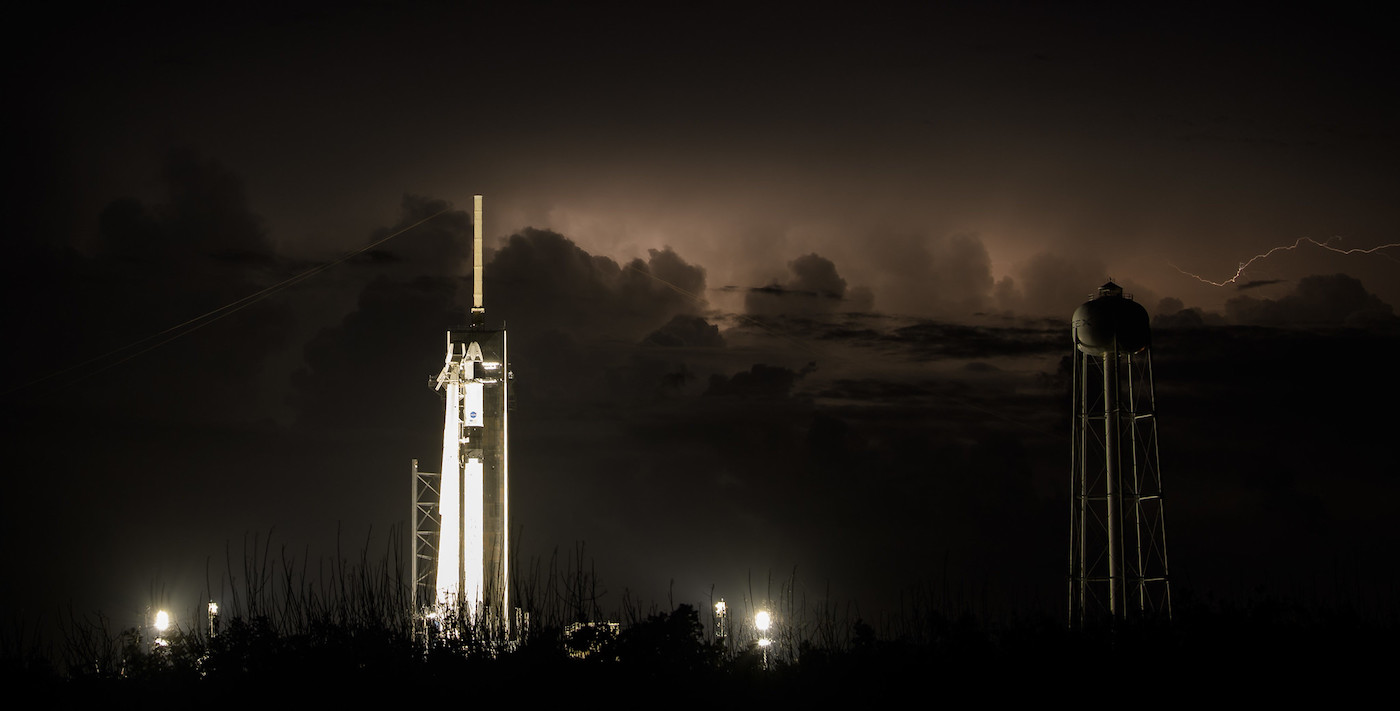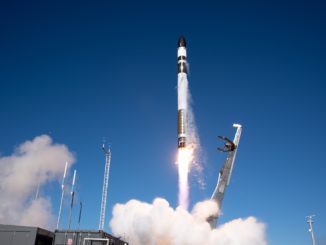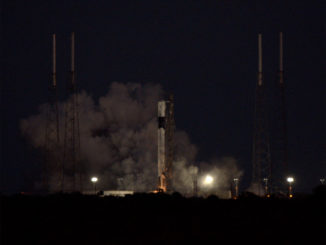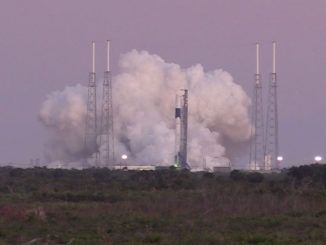EDITOR’S NOTE: SpaceX successfully launched the Falcon 9 mission mentioned in this story at 3:24 a.m. EST (0824 GMT) on Thursday, March 4.

Launch companies and U.S. Space Force range officials at Cape Canaveral are reassessing long-standing weather rules, looking at beefing up rocket defenses against lightning, and considering strategies to prepare for two different launch windows on a given day to guard against weather delays, something SpaceX may demonstrate with a Falcon 9 launch early Thursday.
The moves could open up more launch opportunities on the Eastern Range, which manages support infrastructure and oversees range safety at the Florida spaceport.
Brig. Gen. Stephen Purdy, commander of the 45th Space Wing, said Feb. 23 that launch providers requested 297 launch opportunities in the previous 12 months. Range officials approved 225 of those requests, and 55 of those launch opportunities went into countdown operations, resulting in 32 launches, Purdy said last week at the 47th Spaceport Summit.
Purdy said the Space Force wants to be able to approve all launch opportunity requests on the Eastern Range, providing companies with services more akin to an airport than the way government-run spaceports typically operate. That requires a change in mentality and thinking, he said.
Officials are looking at all pieces of launch support infrastructure — from transportation to electricity, communications, security, and propellants and high-pressure gases — “to figure out how to break through any of the pieces that are limiting us in order to get to that launch-on-demand” goal, Purdy said.
One area for improvement is reducing the number of weather-related launch delays at Cape Canaveral, where lightning is a major risk for rockets climbing through the atmosphere.
SpaceX is the most active launch company on the Eastern Range, and many of its Falcon 9 launches have just a one-second launch window. Crew and cargo missions to the International Space Station and launches with Starlink internet satellites have instantaneous windows each day.
And once SpaceX begins filling the Falcon 9 rocket with kerosene and liquid oxygen propellants 35 minutes before launch time, the launch window often shrinks to one second even if there is a longer period available to meet payload requirements. That’s because the Falcon 9 uses super-chilled, condensed propellants, and holding the countdown would cause the liquids to get too warm.
If a launch window stretches several hours, there might be enough time for SpaceX to abort a countdown, recycle the clock, recondition propellant, and then load the Falcon 9 again for a second launch attempt the same day.
The tight one-second launch windows, coupled with SpaceX’s high launch tempo, mean the company’s Falcon 9 rockets are grounded by bad weather more often than other launch vehicles.
Hans Koenigsmann, a senior advisor and former vice president of build and flight reliability at SpaceX, said a fundamental goal is to “improve the vehicle’s susceptibility to lightning,” and then adapt the launch weather rules after verifying it is safe to launch with an increased risk of lightning.
He said the Space Force’s 45th Weather Squadron, which tracks launch weather conditions at Cape Canaveral, is “absolutely amazing.”
“The level of detail that we get is remarkable, how good the forecast is,” Koenigsmann said. “There are launches where we work the entire time with the weather officer and try to find the right time.
“The big problem, in general, is that in many launches you have to launch in one particular second,” Koenigsmann said. “You do not have a a lot of flexibility there, and that might be not a good time. Five minutes later might be a great time, but that is not what you needed for that particular orbit.”
One option SpaceX appears to be trying out this week is developing two different flight plans for a single launch.
SpaceX’s next Falcon 9 mission is set for early Thursday from pad 39A at the Kennedy Space Center, and the company aims to launch the rocket with 60 Starlink internet satellites at 3:24 a.m. EST (0824 GMT). But if a technical issue or bad weather gets in the way, the company has a backup time available at 5:42 a.m. EST (1042 GMT).
The plan would allow SpaceX to launch the Falcon 9 rocket without having to wait nearly 24 hours for the next launch window.
SpaceX would aim to launch the 60 Starlink satellites into one plane, or part, of the Starlink constellation if it takes the first launch opportunity Thursday. The second launch time Thursday would target a different plane in the Starlink network.
Koenigsmann said last week SpaceX could “have two different flight plans” available for a single launch, and managers could decide to take the option with better weather. That strategy is particularly useful for Starlink missions, since the fleet flies in 72 different orbital planes, affording numerous launch opportunities per day.
The launch times are set for when Earth’s rotation brings the launch pad under the targeted orbital plane.
With Thursday’s launch, SpaceX will have launched more than 1,200 Starlink satellites, including prototypes that have since been deorbited. The first-generation fleet of Starlinks will number 1,440 active satellites at an altitude of 341 miles, or 550 kilometers.
SpaceX lands and reuses its Falcon 9 boosters, allowing the company to cut costs and increase its launch cadence. But it comes with another layer of weather criteria.
“There’s also the issue of recovery. You have to have weather both on the launch site and also the landing site,” Koenigsmann said. “This complicates things, too. The weather service from the 45th Space Wing and the Cape help tremendously there.”
For Crew Dragon missions with astronauts, SpaceX also has to consider weather and sea conditions along a corridor downrange from Cape Canaveral, where the capsule might splash down in the event of an in-flight abort. Human missions also come with additional wind constraints at Cape Canaveral to ensure onshore winds are strong enough to blow the spacecraft back toward land if it has to escape the rocket on the launch pad.
“All of these things are complex weather and vehicle interface questions that we need to work on,” Koenigsmann said.
He said one factor working against SpaceX’s plans to “weather-harden” its rockets is that those modifications might make the launch vehicle heavier.
“I feel like there is a whole slew of things that we need to improve on, and not just a single thing, in order to get launch (schedule) reliability up,” Koenigsmann said. “It’s a combination of how we work together, our infrastructure, our logistics.”
“Success is defined for us as moving from a biweekly, or every other week launch, to a weekly launch, and then later on to a daily launch while safely reusing the same hardware,” Koeingsmann said. “That’s a tall order. We are, I think, halfway along the way here.”
Purdy said the Eastern Range can accommodate more launches with the introduction of automated flight termination systems, equipment that flies on rockets to autonomously determine if the vehicle is veering off its pre-planned trajectory. If it does fly off course, the automated system is designed to terminate the flight to avoid placing the public and property at risk.
SpaceX uses the automated safety system on all of its launches, and the Space Force says all range users should transition to the new technology by 2025. Traditional human-in-the-loop flight termination systems require a range safety officer to monitor the rocket’s trajectory from the ground, and then manually issue a command to destroy the rocket if necessary.
Purdy said the “command destruct” system requires a “not insignificant amount of personnel and equipment.”
“When we don’t have to have those up — for example, the days that we have SpaceX launching their Falcon 9 — we have fewer people on the range and more streamlined processes, and more flexibility, which is exactly what we’re trying to get to for the rest of the launch systems,” Purdy said.
The Defense Department charges commercial launch companies for the range support at Cape Canaveral.
The 45th Space Wing is eventually eyeing a switch to automated range scheduling to handle more requests from launch providers. Each range request currently takes “multiple hours of coordination” with security, safety, weather, and other teams, including the Federal Aviation Administration, which must help clear airspace over the launch site.
“I think the ability to turn the range and dynamically schedule the range are the two things that will make the most immediate impact,” said Scott Henderson, vice president of Blue Origin’s operations in Florida. “Going to autonomous flight safety allows you to turn the range much faster … But that dynamic scheduling, the ability to do all the pre-work and then quickly schedule when you’re ready.”
Blue Origin is developing the New Glenn rocket for launches from Complex 36 at Cape Canaveral Space Force Station. Along with SpaceX and United Launch Alliance, other companies with plans to fly rockets from Cape Canaveral include Firefly Aerospace and Relativity Space, which are developing smaller orbital-class boosters.
“There are clearly going to be conflicts,” Henderson said. “Complex 36 is just down the coast from Landing Zone 1, so any time a SpaceX booster is landing on Landing Zone 1, we have to clear LC-36. Any time New Glenn launches from Launch Complex 36, SpaceX will have to clear Landing Zone 1. I think those things happen up and down launch row there. As we add more launch providers, that’s going to be more dynamic, but then again that’s why you have to basically be able to efficiently use the slots you have, use the range capability you have, use people you have. It goes all the way back to process, people, and hardware, and we’re going to have to figure out a way to do that.”
The weather team at Cape Canaveral is “really active” in work to innovate and update launch weather criteria, Purdy said.
“They’ve had multiple projects that are underway, and some that have completed, to keep nibbling away at the weather question,” Purdy said. “They’ve had some that get into how can we clear ourselves a little bit more space in the cumulus (cloud rule). They’ve got another one they’re working to try to squeeze the lightning ring from 5 miles to 4 miles.”
Lightning is more common along Florida’s Space Coast than at any other spaceport. But other launch sites have encountered lightning, including a 2019 launch of a Russian Soyuz rocket from from the Plesetsk Cosmodrome in northern Russia, which persevered through a lightning strike and still delivered its satellite payload into orbit.
A Russian Soyuz rocket carrying a Glonass navigation satellite withstood a lightning strike seconds after liftoff Monday, and still delivered its payload to orbit. FULL STORY: https://t.co/Nt35ZiSTQk pic.twitter.com/NGXUmgjSk0
— Spaceflight Now (@SpaceflightNow) May 28, 2019
Many of the lightning-related constraints for launches from Cape Canaveral were developed after lightning struck NASA’s Saturn 5 moon rocket on the Apollo 12 mission in 1969, and following a lightning hit on an Atlas-Centaur rocket in 1987.
The Saturn 5 rocket carrying three Apollo astronauts to the moon continued climbing into space after it was hit by lightning, but the sudden charge temporarily disrupted the spacecraft’s guidance system. The mission recovered and headed on to the moon.
An Atlas-Centaur rocket lifted off with a U.S. Navy communications satellite in March 1987, and lightning hit the launcher 49 seconds into the mission. The Atlas-Centaur, known as AC-67, was not as lucky, and the lightning caused a guidance, navigation, and control system failure. The guidance computer issued an errant command for the engines to suddenly steer the rocket in a different direction, resulting in the structural break-up of the launcher, according to NASA.
Investigators probing the AC-67 failure recommended establishing surface electric field limits for future rocket launches. Those field mill rules have been in effect at Cape Canaveral since the AC-67 investigation.
Weather officers monitor the surface electric field measurements along with cumulus clouds, anvil clouds from nearby thunderstorms, and thick clouds within the atmosphere’s freezing layer. Rockets with conductive surfaces and ionized exhaust plumes can distort electric fields within such clouds, triggering a lightning strike that might otherwise not occur.
The triggered lightning concern was not part of launch weather criteria before the Apollo 12 lightning strike, according to NASA.
Henderson said Blue Origin is “investing on the technical infrastructure to make the rocket more robust against lightning, so in order to be able to absorb a lightning strike and not be impacted, either through redundancy or hardening of systems.”
“The idea is you can launch a rocket any time an airplane is taking off from Orlando airport. That’s kind of where we want to get to.”
Email the author.
Follow Stephen Clark on Twitter: @StephenClark1.



